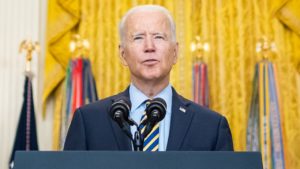
President Joe Biden delivers remarks on the drawdown of U.S. troops from Afghanistan, Thursday, July 8, 2021, in the East Room of the White House. (Official White House Photo by Hannah Foslien)
After two decades in Afghanistan, the decision to leave the country does not necessarily need defending. More important is, (1) will the debacle in Afghanistan undermine the Biden administration’s foreign policy goals, and (2) why did the withdrawal go so poorly,
Joe Biden is attempting to blame the collapse on former President Trump, whose administration was leading negotiations between the Taliban and the Afghanistan government, writes Amber Athey in the American Spectator.
Biden claimed in his speech that he inherited a choice of following through on Trump’s deal or getting into an intense conflict with the Taliban. This is obviously a false binary, as Biden faced neither of those things. Instead, he ignored the conditions-based framework of Trump’s deal and extended the deadline to September 11, 2021.
Critics of Trump’s approach may argue that a ‘conditions-based’ withdrawal really meant ‘never’. But Trump had reduced the number of troops from around 15,000 to 2,500 despite constant pushback from his own administration officials and military generals. Plus, the 2,500 troops remaining at the end of Trump’s term is still far fewer than the 6,000 Biden just deployed to make up for his botched withdrawal.
Critics of Trump are busy insisting that his dramatic drawdown was more to blame for the collapse of the Afghan government than anything Biden did. But the fact remains that Afghanistan didn’t collapse after Trump reduced troop numbers. It fell catastrophically straight after Joe Biden’s withdrawal.
Biden refused questions from the press (many of whom have never asked him a tough question about anything), before bolting out of the White House “like he had a flight out of Kabul to catch to settle back in at Camp David,” reports BRIGHT editors.
If you’re willing to fight for Main Street America, click here to sign up for the Richardcyoung.com free weekly email.




